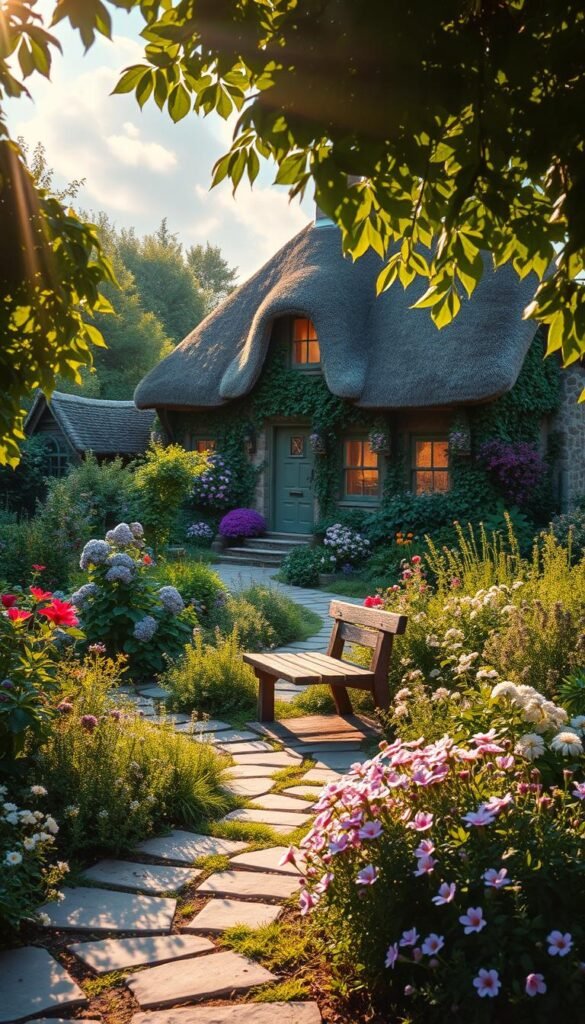Imagine stepping into a space where time slows down. Sunlight filters through wildflowers, bees hum lazily around lavender bushes, and weathered stone paths lead to secret nooks. This isn’t a storybook scene—it’s a living, breathing retreat you can cultivate right outside your door.
The charm of this design philosophy lies in its celebration of simplicity. Think rustic charm paired with nature’s untamed beauty: climbing roses framing a wooden gate, herbs spilling from terracotta pots, and the soft whisper of birch leaves overhead. It’s about creating a sanctuary that feels both nostalgic and alive.
Rooted in romanticized rural traditions, this approach blends practicality with whimsy. Picture elements borrowed from the English countryside—think weathered benches, vintage watering cans, and loose arrangements of peonies and daisies. Every detail invites you to pause and savor the moment.
In this guide, you’ll discover how to infuse your outdoor space with warmth and character. We’ll explore plant choices that thrive with minimal fuss, design tricks to mimic centuries-old landscapes, and ways to repurpose found objects into functional art. Let’s begin crafting your own slice of magic.
Understanding the Cottagecore Garden Aesthetic
At its core, this style whispers of unpolished charm. It’s about letting plants grow freely while crafting spaces that feel lived-in and welcoming. Think wild roses spilling over fences or daisies dotting a grassy path—designs that celebrate nature’s rhythm over rigid perfection.
Embracing Simplicity and Natural Beauty
Forget manicured hedges. Here, clusters of lavender mingle with sage, and sun-bleached wooden benches blend into the scenery. The magic lies in balancing color and texture without overthinking—letting foxgloves tower beside feathery grasses or allowing ivy to climb stone walls at its own pace.
Historical Inspirations From the English Countryside
Centuries-old farmsteads and cottage plots shaped this effortless look. Picture hollyhocks framing weathered doors or herbs thriving in cracked pottery—a nod to rural life where beauty served purpose. These traditions remind us that gardens can be both productive and poetic.
By honoring these roots, you create more than a plot of land. You cultivate a sense of connection—to history, seasons, and the quiet joy of watching life unfold untamed.
Designing Your Dream Cottagecore Garden
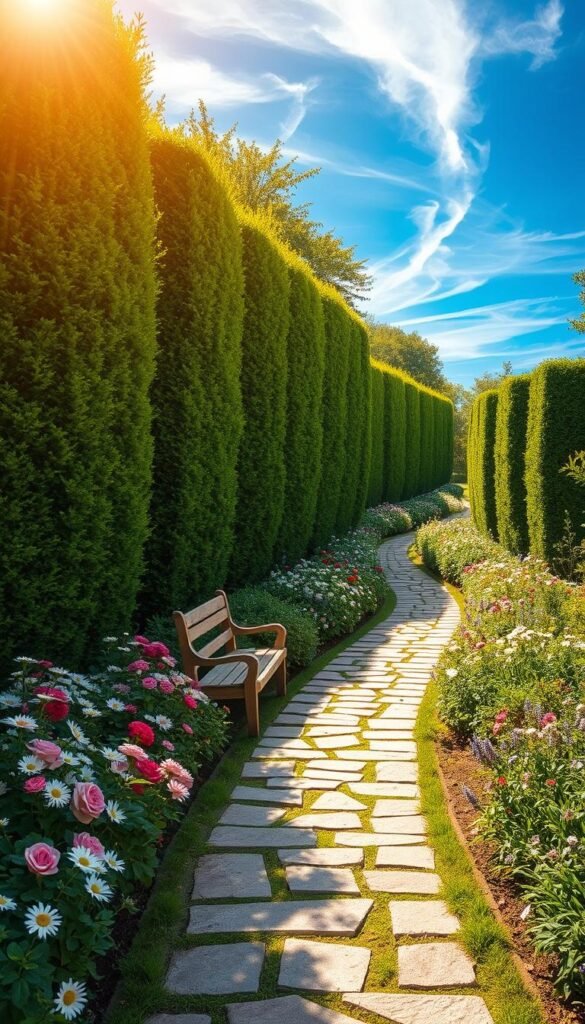
Your garden becomes a story written in petals and pathways. Start by observing how nature arranges itself—clusters of blooms, uneven clearings, and winding animal trails. Let these patterns guide your layout instead of rulers or grids.
Planning a Natural, Unstructured Layout
Ditch symmetry. Allow plants to mingle like old friends, with taller species peeking behind shorter ones. Place seating areas where sunlight naturally pools, and let groundcovers spill onto walkways. Embrace imperfections—a slightly crooked trellis or uneven stone border adds character.
Curved Pathways and Organic Flow
Meandering paths invite discovery. Use materials like gravel or mossy bricks that soften edges over time. Curve walkways around existing trees or flower patches instead of removing them. Studies show winding routes double exploration time compared to straight lines, making small spaces feel expansive.
| Feature | Traditional Design | Cottagecore Approach |
|---|---|---|
| Path Shape | Straight lines | Gentle curves |
| Edging | Precise metal/plastic | Weathered wood or stones |
| Plant Placement | Evenly spaced rows | Dense, overlapping clusters |
Mix practicality with playfulness. Tuck a tiny bench under a willow, or let strawberry plants edge your vegetable patch. Transitioning from formal to free-flowing? Start by softening lawn edges with creeping thyme, then add curved beds over time.
Cottagecore Aesthetic: Bringing Fairytale Vibes to Your Garden
There’s a quiet magic in spaces that feel both discovered and designed. Picture morning light catching dew on spiderwebs between foxgloves, or the soft creak of a wooden gate adorned with honeysuckle. These moments transform ordinary gardens into living storybooks where every corner whispers possibility.
Creating this atmosphere relies on balancing wildness with intention. Let rambling roses frame a salvaged iron archway, or place a chipped teacup planter among your thyme. Vintage tools become art when hung on sun-warmed stone walls, while clusters of daisies appear to have sprung up spontaneously.
Even compact spaces gain depth through layered textures. Try these contrasts:
| Element | Modern Approach | Storybook Style |
|---|---|---|
| Lighting | LED spotlights | Lanterns with flicker bulbs |
| Ground Cover | Mulch | Clover or chamomile |
| Decor | Plastic ornaments | Hand-painted birdhouses |
The true secret? Let your space evolve like a favorite novel—each season adding new chapters. Maybe this year, a willow branch arch grows over your reading bench. Next spring, milkweed might attract monarchs to your garden’s edge. These organic changes keep the magic alive.
As we explore plant choices later, remember: your outdoor area becomes enchanted when it reflects your version of wonder. Whether through heirloom vegetables or a mossy stepping stone path, every detail contributes to the spell.
Selecting the Right Plants for a Cottagecore Garden
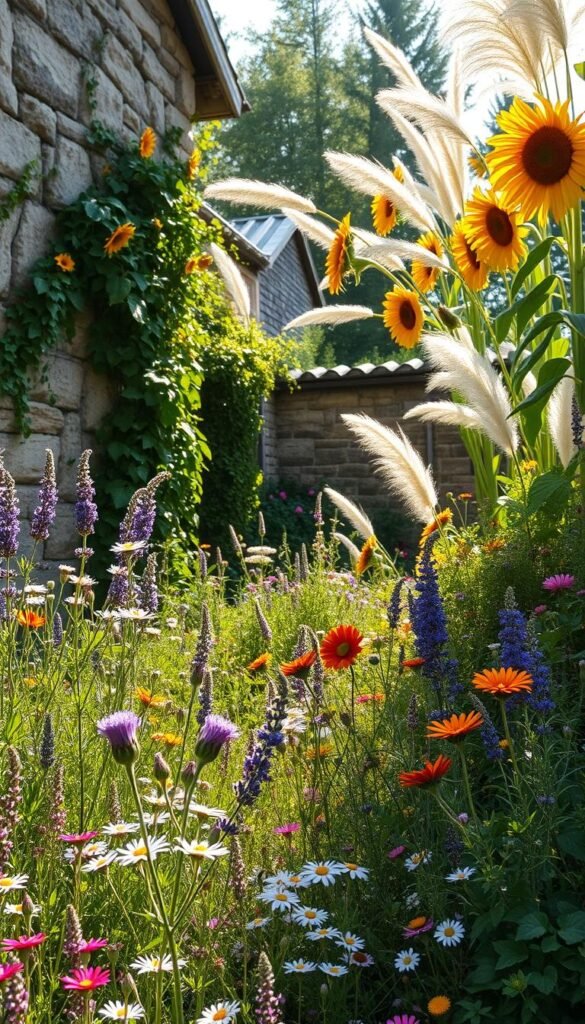
Your plant choices shape the soul of your outdoor retreat. Mix blooms and edibles to create layers that delight the senses while serving multiple purposes. Aim for a palette of soft mauves, buttery yellows, and creamy whites—colors that harmonize like watercolor washes. Antique roses and lavender anchor this look, while wildflowers like cornflowers add spontaneous charm. For small spaces, patio container gardening lets you cluster foxgloves with thyme in weathered pots.
Florals and Wildflowers
Prioritize flowers that feel discovered rather than planted. Self-seeding varieties like poppies or forget-me-nots create effortless drifts of color. Hollyhocks tower beside fences, their papery blooms nodding in the breeze. Stick to a loose color story—blush pinks paired with violet salvias, or sunny daisies contrasting with deep purple iris.
Edable Herbs and Vegetables
Don’t relegate practical plants to hidden corners. Let rosemary’s silvery stems complement rose bushes, or train scarlet runner beans up a rustic trellis. Edible lavender doubles as a pollinator magnet, while rainbow chard adds jewel-toned foliage. Tuck parsley between peonies, or let purple basil echo your lilac’s hue.
Balance is key. Dedicate 60% of beds to ornamentals and 40% to edibles. This ratio maintains visual magic while yielding herbs for tea or veggies for summer salads. Your space becomes both gallery and pantry—a true celebration of nature’s dual gifts.
Utilizing Color, Texture, and Fragrance in Your Garden
A garden becomes a sensory journey when you engage sight, touch, and smell. Start with a palette of muted peaches, powdery blues, and creamy ivories—colors that blend like dawn light. For contrast, tuck in bold accents: deep purple salvias or crimson poppies that pop against softer hues.
Texture adds depth to your outdoor canvas. Pair feathery ferns with velvety lamb’s ear leaves, or let spiky lavender play against rounded hydrangea blooms. This mix creates visual rhythm, guiding the eye through natural layers rather than perfect rows.
Fragrance transforms spaces into memory-makers. Plant old-fashioned roses near seating areas where their perfume lingers. Intersperse herbs like lemon thyme between stepping stones—each step releases citrusy whispers. For evening magic, add night-blooming jasmine near windows.
Layer scents by height: ground-level chamomile, waist-high lavender, and overhead honeysuckle. This vertical approach ensures aromas surround you without overwhelming. Remember, subtlety works best—a few well-placed fragrant plants outshine crowded beds.
When color, texture, and fragrance harmonize, your space feels alive. It’s not just about looks—it’s about crafting an experience where every sense finds joy in the garden’s embrace.
Incorporating Natural Materials and Vintage Decor
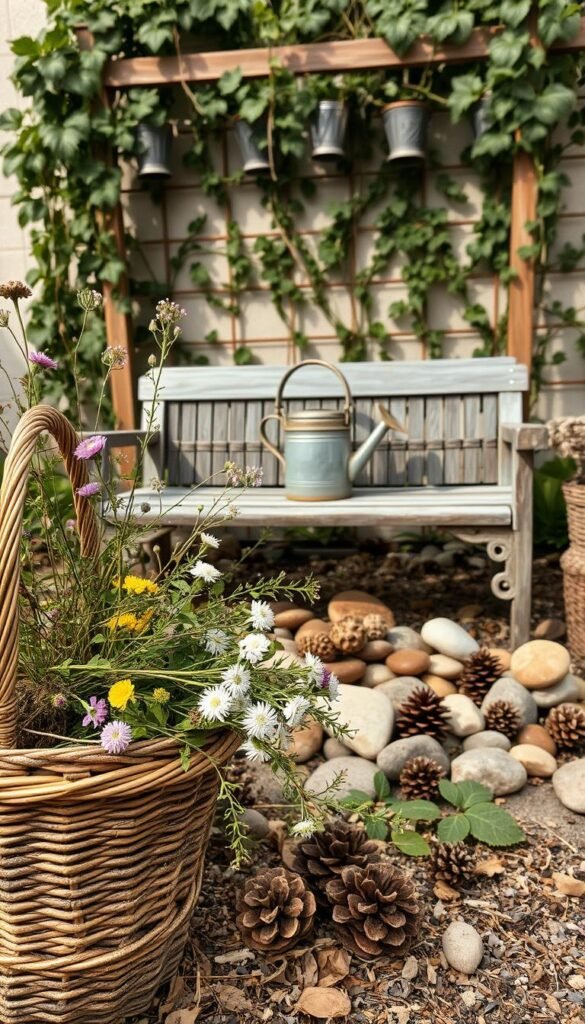
Your outdoor space gains soul through the stories its materials tell. Weathered stone paths and reclaimed wood fences whisper of simpler times, while chipped teacups turned planters add playful nostalgia. These elements blend sustainability with character, creating spaces that feel both timeless and deeply personal.
Stone Paths and Wooden Fences
Crushed limestone or irregular flagstones make magical walkways. Let moss fill the gaps between stones for an aged look. Pair them with rough-hewn cedar fences—their silvered patina mirrors tree bark. For borders, stack flat river rocks instead of plastic edging. They’ll host lichens and beetles, boosting biodiversity.
Upcycled Garden Accents
Transform forgotten items into functional art. An old ladder becomes a vertical herb planter. Cracked ceramic bowls host succulents when filled with gravel. Even colorful container gardening shines in repurposed tin cans or enamelware—bright blooms contrast beautifully with weathered metals.
| Feature | Modern Materials | Rustic Alternatives |
|---|---|---|
| Pathways | Concrete pavers | Irregular slate pieces |
| Planters | Plastic pots | Galvanized buckets |
| Furniture | Polywood chairs | Peeled branch benches |
These choices do more than beautify. They reduce waste and connect your home to land stewardship traditions. A rusted gate hinge becomes a trellis clip. Driftwood stakes support climbing beans. Each piece carries history while nurturing new growth.
Creating Intimate Enclosures and Cozy Nooks
Hidden corners hold special magic in any outdoor space. By carving out small retreats, you craft pockets of calm where sunlight dapples through leaves and birdsong feels closer. These sanctuaries invite you to linger over morning coffee or lose yourself in a novel’s pages.
Secluded Seating Areas for Quiet Retreats
Start by framing your hideaway with living walls. Tall grasses, flowering hedges, or ivy-covered trellises create natural privacy screens. Place a weathered bench or repurposed wooden chairs where shadows dance—under a tree canopy or beside climbing roses. Add texture with linen cushions in earthy tones.
Vintage finds add instant character. An old iron bed frame becomes a daybed draped with mosquito netting. Paint-chipped step stools serve as side tables for teacups and seed catalogs. For DIY charm, build a twig arbor using fallen branches—it’ll host sweet peas by summer.
Define zones with subtle shifts in ground cover. A circle of crushed shells marks a reading area, while clover softens footpaths between seating spots. String Edison bulbs overhead for twilight glow, or tuck solar lanterns among ferns to guide evening strolls.
Even compact gardens gain depth with layered seating. Try a bistro set for two near your container gardening basics, paired with a single Adirondack chair under the lilacs. These purposeful arrangements make every square foot feel intentional yet effortless.
Remember: coziness thrives in details. A wool throw draped over a rocking chair. Wind chimes whispering in the breeze. By designing small-scale sanctuaries, you transform your entire space into a tapestry of quiet joys.
Embracing Plant Diversity for Year-Round Interest
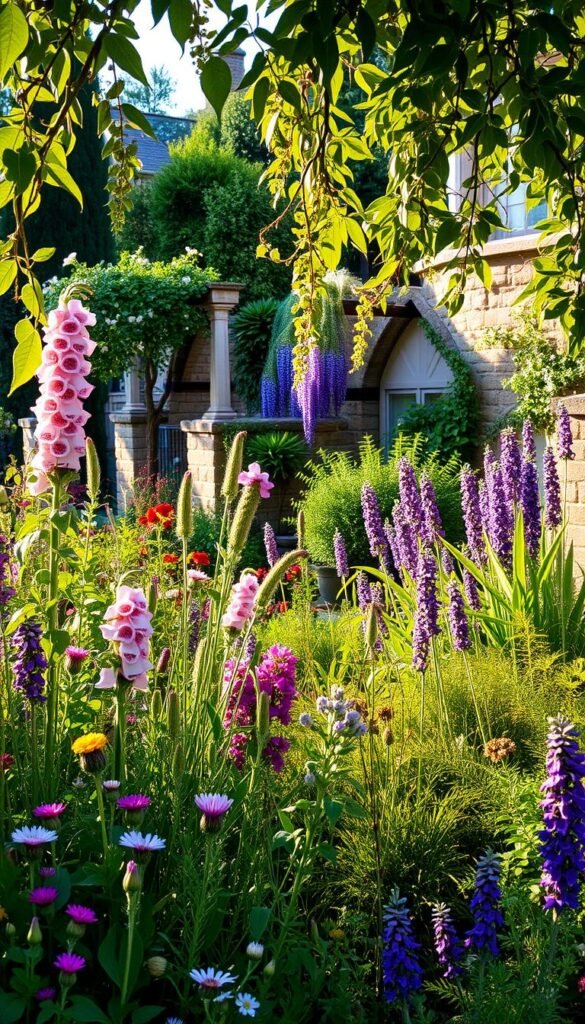
A truly enchanting garden dances through the seasons, never losing its magic. By blending plants that shine in different months, you create a living canvas that evolves from spring’s pastel blooms to winter’s evergreen whispers. This approach ensures your space remains inviting whether surrounded by summer butterflies or frosted morning dew.
Seasonal Blooms and Shifting Hues
Let early tulips and daffodils herald spring, then pass the baton to peonies and cosmos in summer. Autumn’s goldenrod and asters keep the show alive until frost. Self-seeding annuals like poppies add surprise splashes of color, while perennials like coneflowers provide reliable structure.
Evergreens and Perennials for Continuous Charm
Boxwood hedges or rosemary shrubs anchor beds with year-round greenery. Silver-gray lamb’s ear leaves contrast beautifully with snow, while ornamental grasses sway in winter winds. These hardy plants ensure your space never feels barren, even during dormancy.
| Season | Star Plants | Color Palette |
|---|---|---|
| Spring | Bleeding heart, forget-me-nots | Soft pinks, blues |
| Summer | Lavender, Shasta daisies | Purples, whites |
| Autumn | Sedum, Russian sage | Mauves, golds |
Balance is key. Allow 30% of your beds for seasonal showstoppers and 70% for reliable performers. This mix maintains the effortless charm of a cottagecore garden while ensuring constant visual interest. Let climbing nasturtiums spill over evergreen herbs, or plant snowdrops to bloom through last year’s fallen leaves.
With thoughtful planning, your outdoor sanctuary becomes a theater where nature’s cycles take center stage—each act more captivating than the last.
Integrating Climbing Vines and Dainty Trees
Vertical layers breathe life into your outdoor space, transforming flat landscapes into living tapestries. Climbing plants soften hard edges, while petite trees create natural canopies that filter sunlight into dappled patterns. These elements add depth and movement, making even modest gardens feel lush and layered.
Showcasing Climbing Roses and Vines
Train fragrant climbers like roses or clematis on weathered trellises or stone walls. Use soft twine to guide stems without damaging them. For quick coverage, pair fast-growing honeysuckle with slower-blooming varieties. This creates staggered interest across seasons.
Vines like jasmine or sweet peas thrive in partial shade. Let them scramble over arbors or curl around fence posts. Their delicate blooms add whimsy, while their height draws the eye upward, making small spaces feel grander.
Selecting Trees That Enhance the Aesthetic
Choose trees that complement your garden’s scale. Flowering dogwoods offer spring blossoms and autumn berries. Japanese maples provide fiery fall color and graceful silhouettes. Both stay compact, fitting seamlessly into cozy corners.
| Tree Variety | Mature Height | Key Features |
|---|---|---|
| Crabapple | 15-20 ft | Spring blooms, winter berries |
| Redbud | 20-30 ft | Heart-shaped leaves, early flowers |
| Witch Hazel | 12-15 ft | Winter blooms, spicy fragrance |
Underplant trees with shade-loving perennials like hostas or ferns. This creates a layered look while maximizing your space. For extra charm, hang a swing from a sturdy branch or nestle a bench beneath the canopy.
Enhancing Biodiversity and Attracting Wildlife
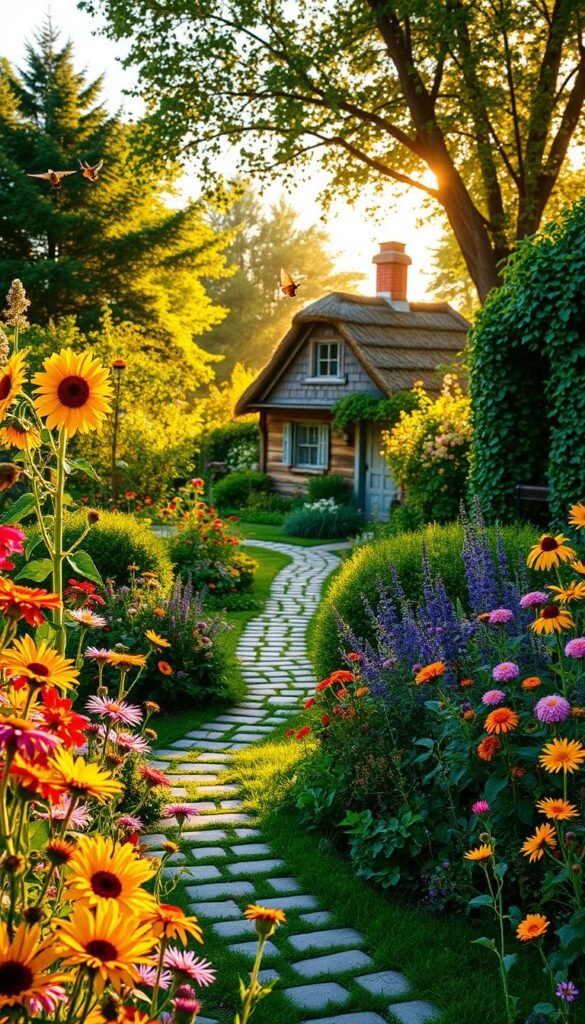
A lively garden thrives when nature’s helpers feel at home. By welcoming bees, butterflies, and birds, you create a vibrant ecosystem that sustains itself. Diverse plantings offer food and shelter while keeping your space visually enchanting.
Choosing Pollinator-Friendly Plants
Focus on blooms that serve dual purposes—beauty and utility. Old-fashioned roses with open petals attract bees, while lavender’s purple spikes draw butterflies. Cluster these near fruit trees or vegetable patches to boost pollination rates naturally.
Incorporate native wildflowers like coneflowers or milkweed. Their familiar shapes and nectar content support local species. A mix of bloom times ensures year-round sustenance:
| Plant | Bloom Time | Wildlife Attracted |
|---|---|---|
| Bee Balm | Summer | Hummingbirds, bees |
| Goldenrod | Fall | Butterflies, beetles |
| Crocus | Early Spring | Emerging bees |
Add shallow water dishes with stones for drinking spots. Leave patches of bare soil for ground-nesting bees, and stack fallen branches to shelter beetles. These small touches create microhabitats without disrupting your cottagecore garden aesthetic.
Remember: biodiversity isn’t just about species count. It’s the hum of life that makes gardens feel truly magical—a chorus of wings, whispers, and wonder.
Mixing Practicality with Elegant Garden Design
A garden that nourishes both body and soul blends beauty with purpose. By weaving edible plants into your landscape, you create spaces where lavender sways beside lettuce and rosemary perfumes the air near roses. This approach marries function with charm, turning every corner into a feast for the senses.
Growing Edible Herbs for Function and Flair
Rosemary’s silvery stems make perfect companions for peonies, while thyme spills artfully over stone edges. These herbs offer fresh flavors for your kitchen while attracting pollinators. Cluster them near seating areas where their fragrance enhances relaxation.
Try these pairings:
| Herb | Ornamental Partner | Practical Benefit |
|---|---|---|
| Purple Basil | Lilac bushes | Repels mosquitoes |
| Lemon Balm | Shasta Daisies | Calming tea source |
| Sage | Lavender | Deters cabbage moths |
Designing Functional Garden Spaces
Create paths lined with chamomile—soft underfoot and perfect for tea. Use raised beds edged with strawberries, blending vegetables with blooms. A trellis of scarlet runner beans becomes both privacy screen and pantry.
Incorporate subtle elements like repurposed troughs for herbs or vintage crates holding potted mint. These touches maintain elegance while supporting sustainable gardening habits. Your outdoor space becomes an extension of your home, where beauty and bounty grow side by side.
Tips for Low Maintenance Cottagecore Gardening
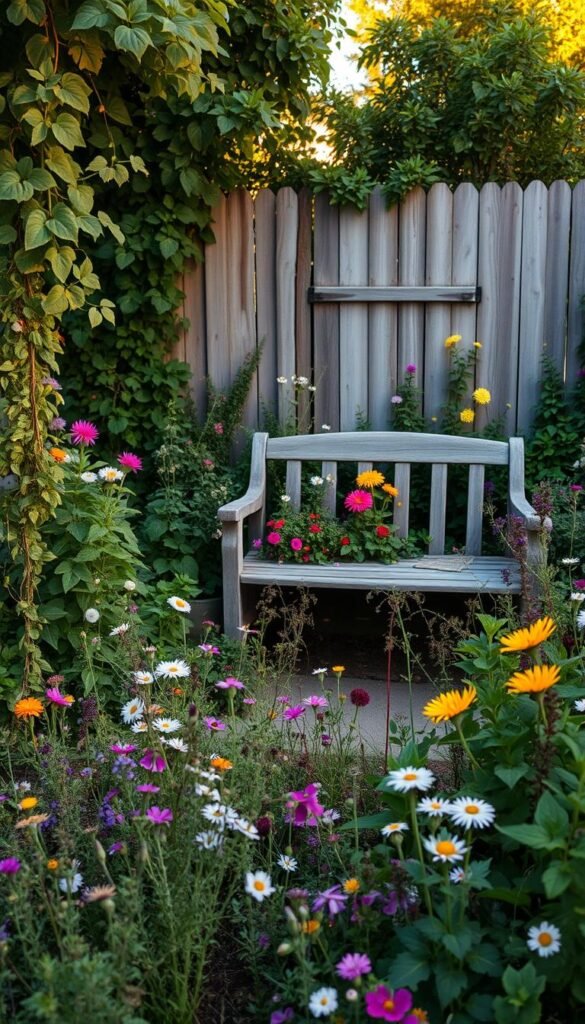
A thriving garden shouldn’t demand constant attention. Start by choosing self-sufficient plants like coneflowers, sedum, and catmint. These varieties flourish with minimal watering and naturally resist pests, letting you enjoy their beauty without endless upkeep.
Mulch becomes your secret ally. A thick layer of straw or shredded bark keeps soil moist, blocks weeds, and breaks down to nourish plants. Pair this with strategic companion planting—marigolds deter beetles near tomatoes, while mint repels cabbage moths.
Design smart from the beginning. Group plants with similar needs together, like drought-tolerant lavender and sage in sunny spots. Use creeping thyme between stepping stones instead of high-maintenance grass. These choices cut watering time and create a lived-in charm.
Many gardeners find success with natural pest solutions. A shallow dish of beer lures slugs away from hostas, while ladybugs devour aphids. One grower in Vermont transformed her yard by replacing fussy roses with native bee balm and wild bergamot—now her space buzzes with life but rarely needs weeding.
Remember: the goal is a space that feels abundant, not burdensome. Let clover fill bare patches, embrace slightly overgrown corners, and celebrate plants that thrive on neglect. Your garden becomes a sanctuary where both flora and gardener can breathe easy.
Balancing Modern Comforts with Rustic Charm
Your outdoor space becomes a bridge between eras when blending contemporary ease with countryside character. Picture plush cushions on a weathered bench or solar-powered lights strung above a reclaimed wood table. This mix lets you enjoy today’s conveniences while honoring the timeless appeal of simpler times.
Repurposing Vintage Furniture and Decor
Old items tell stories. A chipped iron bed frame becomes a daybed draped with linen. Wooden crates stack into a vertical herb planter. These pieces add authenticity without sacrificing comfort. Look for flea market finds like enamelware pitchers holding cut flowers or galvanized buckets turned into firewood holders.
Using Sustainable, Natural Materials
Choose materials that age gracefully. Reclaimed barn wood builds raised beds, while local stone creates meandering paths. These choices reduce waste and connect your home to the land’s history. Pair them with modern touches like weather-resistant fabrics or efficient irrigation systems.
| Modern Element | Rustic Pairing | Purpose |
|---|---|---|
| Outdoor sectional | Handwoven wool throw | Adds texture and warmth |
| LED string lights | Vintage mason jars | Soft, eco-friendly lighting |
| Composite decking | Moss-filled stone gaps | Durability meets natural charm |
Balance is key. A concrete fire pit surrounded by tree stump seats mixes sleek and organic. Use native plants in upcycled containers near your seating area—beauty that thrives with little effort. Your space becomes a living testament to thoughtful design where past and present coexist beautifully.
Adapting Cottagecore Styles to Any Outdoor Space
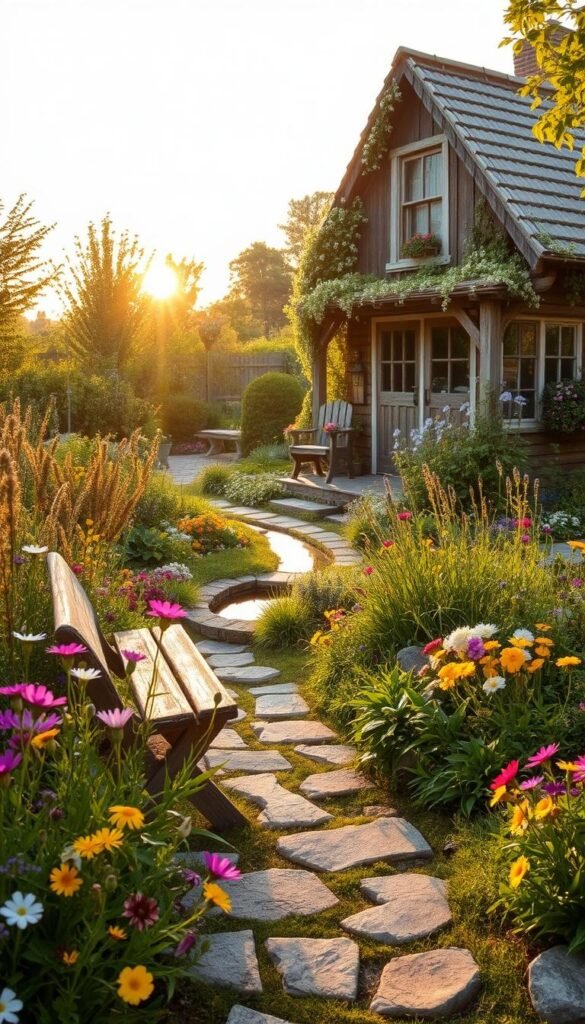
Your outdoor retreat can bloom anywhere—whether you’re tending a fire escape planter or a sprawling meadow. The secret lies in scaling elements to fit your space while preserving that storybook charm. Let’s explore how to translate this design philosophy across different landscapes.
Urban Cottage Gardens versus Countryside Retreats
City dwellers often focus upward. Use vertical planters bursting with trailing nasturtiums or compact fruit trees in whiskey barrels. Balcony railings become supports for sweet pea vines, while window boxes overflow with thyme and pansies. Rural areas lean into sprawling flower beds and wild hedgerows, but both share a love for timeworn materials and self-seeding blooms.
| Feature | Urban Approach | Countryside Approach |
|---|---|---|
| Space Use | Vertical planters, hanging baskets | Winding paths, mixed borders |
| Plant Choices | Dwarf fruit trees, compact herbs | Rambling roses, native wildflowers |
| Hardscaping | Repurposed crates as raised beds | Fieldstone walls, gravel drives |
Flexible Layout Solutions for Small Areas
Even a 10×10 plot can feel enchanted. Create depth by layering plants—tall foxgloves at the back, creeping mint along edges. A curved path of irregular stones makes the area appear larger. Use multipurpose features: a vintage ladder holds potted strawberries while serving as art.
Try these space-maximizing ideas:
- Paint a mural of distant hills on a fence to create illusionary depth
- Install a mirror among climbing ivy to double visual interest
- Use folding furniture that tucks away when not needed
Remember: magic thrives in constraints. A single apple tree becomes a focal point. A cluster of daisies in chipped teacups whispers whimsy. Your garden, whatever its size, becomes a canvas for personal expression.
Exploring Innovative Garden Decor Ideas
Your outdoor space becomes a canvas for storytelling when decor bridges past and present. Imagine vintage headboards transformed into rose arbors or chipped teacups cradling alpine succulents. These creative elements breathe new life into forgotten objects while honoring rustic traditions.
Natural materials create pathways to wonder. Try irregular slate pieces arranged like stepping stones, their gaps filled with creeping thyme. Reclaimed barn wood makes striking planters for lavender and daisies—their weathered texture contrasting with delicate blooms.
Subtle surprises elevate the look. Hang antique colanders as hanging baskets near your home’s entrance. Line walkways with solar-powered mason jars filled with marble chips that glow at dusk. These touches add magic without overwhelming the senses.
| Traditional Decor | Innovative Twist | Impact |
|---|---|---|
| Birdbath | Repurposed sink basin | Adds rustic charm |
| Garden bench | Vintage sleigh conversion | Creates conversation piece |
| Potting station | Ladder shelf with tin pails | Saves space, adds height |
Color plays clever tricks in compact areas. Paint an old wheelbarrow in muted sage and fill it with pink cosmos—the faded hue lets flowers shine. For shady corners, arrange mirror fragments among ferns to bounce light through dark spaces.
Don’t fear mixing eras. A modern concrete sphere looks striking beside a moss-covered well bucket. Your cottagecore garden becomes truly yours when personal memories mingle with design—like grandmother’s quilts draped over Adirondack chairs. Start small: one unconventional planter, one unexpected texture. Let the rest grow naturally.
Transforming Your Space into a Cottagecore Sanctuary
Every corner of your outdoor haven can whisper tales of timeless beauty. By blending practical plants with vintage charm, you craft a living story that grows richer each season. Let herbs mingle with roses, let weathered benches invite quiet moments, and let winding paths spark curiosity.
Start small—transplant a lavender sprig into a chipped teapot or outline a seating nook with river stones. Bold experiments often yield the sweetest surprises: scarlet runner vines climbing a repurposed ladder, or kale adding jewel-toned foliage to flower beds. Remember, your space evolves like nature itself—imperfect, dynamic, and deeply personal.
Pair modern comforts with rustic touches. Solar lights nestled in mason jars illuminate reclaimed wood tables, while native vegetables thrive beside heirloom blooms. This balance creates sanctuaries that feel both nostalgic and nourishing.
Your journey begins today. Plant one self-seeding wildflower. Hunt flea markets for a weathered planter. Watch as your garden becomes a testament to creativity—a place where simplicity sings and every detail sparks joy. Here, magic isn’t manufactured—it’s cultivated, one thoughtful choice at a time.

